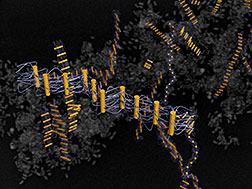- Number 389 |
- May 27, 2013
DNA-guided assembly yields novel ribbon-like nanostructures

DNA-tethered nanorods link up like rungs
on a ribbonlike ladder—a new mechanism
for linear self-assembly that may be
unique to the nanoscale.
Scientists at the Center for Functional Nanomaterials (CFN) at DOE's Brookhaven National Laboratory have discovered that DNA “linker” strands coax nano-sized rods to line up in way unlike any other spontaneous arrangement of rod-shaped objects. The arrangement—with the rods forming “rungs” on ladder-like ribbons linked by multiple DNA strands—results from the collective interactions of the flexible DNA tethers and may be unique to the nanoscale. The research could result in the fabrication of new nanostructured materials with desired properties.
“This is a completely new mechanism of self-assembly that does not have direct analogs in the realm of molecular or microscale systems,” said Brookhaven physicist Oleg Gang, lead author on a paper describing the research in ACS Nano.
“Our discovery shows that a qualitatively new regime emerges for nanoscale objects decorated with flexible molecular tethers of comparable sizes—a one-dimensional ladder-like linear arrangement that appears in the absence of end-to-end affinity among the rods,” Gang said.
Analyses methods at the CFN and Brookhaven’s National Synchrotron Light Source (NSLS) confirmed the ladder-like arrangement. Scanning electron microscopy of samples “frozen” at various times during assembly revealed that the process occurs in stages, first with the formation of the ladder-like ribbons, followed by ribbon stacking and then three-dimensional aggregation.
“Stopping the assembly process at the ladder-like ribbon stage could potentially be applied for the fabrication of linear structures with engineered properties,” Gang said. “For example by controlling plasmonic or fluorescent properties—the materials’ responses to light—we might be able to make nanoscale light concentrators or light guides, and be able to switch them on demand.”
Full story link: http://www.bnl.gov/newsroom/news.php?a=11540.[Karen McNulty Walsh, 631.344.8350,
kmcnulty@bnl.gov]
